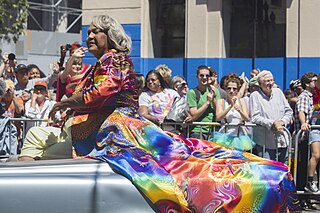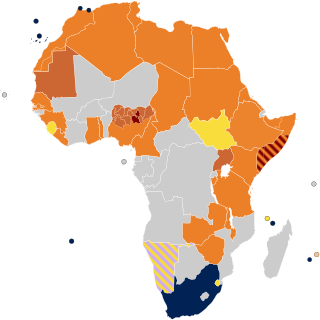Related Research Articles

Lesbian, gay, bisexual, and transgender (LGBT) movements are social movements that advocate for LGBT people in society. Although there is not a primary or an overarching central organization that represents all LGBT people and their interests, numerous LGBT rights organizations are active worldwide. The first organization to promote LGBT rights was the Scientific-Humanitarian Committee, founded in 1897 in Berlin.
Queer studies, sexual diversity studies, or LGBT studies is the study of topics relating to sexual orientation and gender identity usually focusing on lesbian, gay, bisexual, transgender, gender dysphoric, asexual, queer, questioning, and intersex people and cultures.
"Gay agenda" or "homosexual agenda" is a term used by sectors of the Christian religious right as a disparaging way to describe the advocacy of cultural acceptance and normalization of non-heterosexual sexual orientations and relationships. The term originated among social conservatives in the United States and has been adopted in nations with active anti-LGBT movements such as Hungary and Uganda.

Lesbian, gay, bisexual, and transgender (LGBT) people in Ghana face severe challenges not experienced by non-LGBT residents. Sexual acts between males have been illegal as "unnatural carnal knowledge" in Ghana since the colonial era. The majority of Ghana's population hold anti-LGBT sentiments. Physical and violent homophobic attacks against LGBT people are common, and are often encouraged by the media and religious and political leaders. At times, government officials, such as police, engage in such acts of violence. Reports of young gay people being disowned by their families and communities and evicted from their homes are common. Families often seek conversion therapy from religious groups when same-sex orientation or non-conforming gender identity is disclosed; such "therapy" is reported to be commonly administered in abusive and inhumane settings.

Lesbian, gay, bisexual, and transgender (LGBT) people in South Africa have the same legal rights as non-LGBT people. South Africa has a complex and diverse history regarding the human rights of LGBT people. The legal and social status of between 400,000 –over 2 million lesbian, gay, bisexual, transgender and intersex South Africans has been influenced by a combination of traditional South African morals, colonialism, and the lingering effects of apartheid and the human rights movement that contributed to its abolition.
Forest Town, as the name implies, is a leafy suburb of Johannesburg, South Africa. It lies between the busy thoroughfares of Jan Smuts Avenue and Oxford Road, and is bordered to one side by the Johannesburg Zoo.

The Homosexual Law Reform Act 1986 is a New Zealand Act of Parliament that broadly legalised consensual sexual practices between men as well as consensual anal sex regardless of partners' gender. It removed the provisions of the Crimes Act 1961 that criminalised this behaviour. The legislation established a uniform age of consent, setting it at 16 for both same-sex and opposite-sex partners.

Lesbian, gay, bisexual, and transgender (LGBT) people in Uganda face legal challenges not experienced by non-LGBT residents. Same-sex sexual activity is illegal for both men and women in Uganda. Originally criminalised by British colonial laws introduced when Uganda became a British protectorate, these laws have been retained since the country gained its independence.
This is a list of notable events in the history of LGBT rights that took place in the 1960s.

LGBT movements in the United States comprise an interwoven history of lesbian, gay, bisexual, transgender and allied social movements in the United States of America, beginning in the early 20th century. A commonly stated goal among these movements is social equality for LGBT people. Some have also focused on building LGBT communities or worked towards liberation for the broader society from biphobia, homophobia, and transphobia. LGBT movements organized today are made up of a wide range of political activism and cultural activity, including lobbying, street marches, social groups, media, art, and research. Sociologist Mary Bernstein writes: "For the lesbian and gay movement, then, cultural goals include challenging dominant constructions of masculinity and femininity, homophobia, and the primacy of the gendered heterosexual nuclear family (heteronormativity). Political goals include changing laws and policies in order to gain new rights, benefits, and protections from harm." Bernstein emphasizes that activists seek both types of goals in both the civil and political spheres.
This is a list of notable events in the history of LGBT rights that took place in the 1970s.

Lesbian, gay, bisexual, and transgender (LGBT) rights in Africa are generally poor in comparison to the Americas, Western Europe and Oceania.
Communist attitudes towards LGBT rights have evolved radically in the 21st century. In the 19th and 20th century, communist parties and Marxist–Leninist states varied on LGBT rights; some Western parties were among the first political parties to support LGBT rights, while others, especially the Soviet Union and its Eastern Bloc, harshly persecuted people of the LGBT community.
This article gives a broad overview of lesbian, gay, bisexual and transgender (LGBT) history in Canada. LGBT activity was considered a crime from the colonial period in Canada until 1969, when Bill C-150 was passed into law. However, there is still discrimination despite anti-discrimination law. For a more detailed listing of individual incidents in Canadian LGBT history, see also Timeline of LGBT history in Canada.
Section 20A of the Immorality Act, 1957, commonly known as the "men at a party" clause, was a South African law that criminalised all sexual acts between men that occurred in the presence of a third person. The section was enacted by the Immorality Amendment Act, 1969 and remained in force until it was found to be unconstitutional in 1998 by the Constitutional Court in the case of National Coalition for Gay and Lesbian Equality v Minister of Justice.
This is a timeline of notable events in the history of lesbian, gay, bisexual and transgender people in South Africa.
The modern South Korean LGBT rights movement arose in the 1990s, with several small organizations seeking to combat sexual orientation and gender identity discrimination.

There have been pride parades in South Africa celebrating LGBT pride since 1990. South African pride parades were historically used for political advocacy protesting against legal discrimination against LGBT people, and for the celebration of equality before the law after the apartheid era. They are increasingly used for political advocacy against LGBT hate crimes, such as the so-called corrective rape of lesbians in townships, and to remember victims thereof.
The following is a timeline of lesbian, gay, bisexual, and transgender (LGBT) history in the 20th century.
References
- 1 2 3 4 5 Gevisser 1995, p. 30.
- ↑ Gevisser 1995, p. 30-31.
- 1 2 3 4 5 Gevisser 1995, p. 31.
- ↑ Pushparagavan, Dixson. "The History of LGBT Legislation". South African History Online. Retrieved 2020-06-14.
- 1 2 Tucker, Andrew (2011-07-22). Queer Visibilities: Space, Identity and Interaction in Cape Town. John Wiley & Sons. ISBN 978-1-4443-9977-6.
- 1 2 3 Sloss, Thomas (2019). Danger, Deviancy, and Desire in Apartheid South Africa: Visualizing an Exchange of Transnational Homoerotic Commodities (PDF) (Master of Arts in History thesis). Carleton University.
- 1 2 Gevisser, Mark (2014-04-15). Lost and Found in Johannesburg: A Memoir. Macmillan. ISBN 978-0-374-17676-1.
- ↑ Meslani, Zane Lelo (2018-10-05). "The Art and Struggles of Drag". The Mail & Guardian. Retrieved 2020-06-14.
- ↑ Tucker, Andrew (2009). Queer Visibilities: Space, Identity and Interaction in Cape Town. John Wiley & Sons. ISBN 978-1-4443-9977-6.
- ↑ "A Timeline of LGBT South Africa". Boston Gay Men's Chorus. 2018-02-25. Retrieved 2020-06-14.
- ↑ Gunkel 2010, p. 56.
- 1 2 3 Gevisser 1995, p. 32.
- ↑ Gevisser 1995, p. 32-33.
- ↑ Maritz, Johan (3 June 2020). "Is it or is it not LGBTIQ+ Pride Month in South Africa?". Gender Justice. Retrieved 2020-06-14.
- ↑ Gevisser 1995, p. 35.
- ↑ Gunkel 2010, p. 54.
- ↑ Gevisser 1995, p. 33.
Sources
- Gevisser, Mark (1995). "A Different Fight for Freedom: A History of South African Lesbian and Gay Organisation from the 1950s to the 1990s". In Gevisser, Mark; Cameron, Edwin (eds.). Defiant Desire: Gay and Lesbian Lives in South Africa. New York: Routledge. ISBN 978-1-136-65595-1. OCLC 858861634.
- Gunkel, Henriette (2010). The Cultural Politics of Female Sexuality in South Africa. New York: Routledge. ISBN 978-0-203-85603-1. OCLC 536376678.